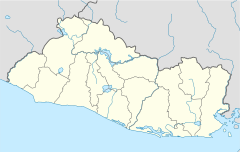Jiquilisco Bay facts for kids
Quick facts for kids Jiquilisco Bay Biosphere Reserve |
|
|---|---|
| Location | Usulután Department, El Salvador |
| Nearest city | Usulután |
| Area | 400 square kilometres (150 sq mi) |
| Established | 2005 |
| Governing body | Ministry of Natural Resources (MARN) |
| Official name: Complejo Bahía de Jiquilisco | |
| Designated: | 31 October 2005 |
| Reference #: | 1586 |
The Jiquilisco Bay Biosphere Reserve is a very special natural area. It is found on the Pacific coast of El Salvador. This beautiful bay is located in the Usulután Department. It is famous for its many mangrove trees. These trees line the bay's waterways.
Jiquilisco Bay is home to lots of coastal and marine birds. It has the largest number of these birds in El Salvador. Many of them are rare or in danger of disappearing. Over 80 types of birds fly here to find food. They eat fish like snook, red snapper, and corvina. Because of its amazing nature, more people are visiting the bay for eco-tourism.
Contents
What is the Jiquilisco Bay Reserve?
The Jiquilisco Bay Biosphere Reserve became a special Ramsar site on October 31, 2005. A Ramsar site is a wetland area that is important worldwide. This means it is protected because of its valuable nature.
The Reserve covers about 400 square kilometers (154 square miles). This includes 50 kilometers (31 miles) of coastline. It is located between the Lempa River and the Jucuarán mountain range. The main waterway into the bay is very long. It is over 43 kilometers (27 miles) long and 3 kilometers (1.9 miles) wide.
Nature in the Bay
The Reserve has the biggest mangrove forest in El Salvador. It also includes bays, canals, sandy beaches, and islands. There are also forests and a group of freshwater lagoons. Jiquilisco Bay helps protect the land from floods and erosion. It also helps keep the soil healthy.
This area is like a nursery for many ocean animals. Young fish and other sea creatures grow up here. Many small communities live near the bay's waters. Local people use the bay's rich natural resources. The area also has farming, shrimp farms, and places where livestock are raised.
Why is Jiquilisco Bay Important for Sea Turtles?
Jiquilisco Bay is one of the two main places where hawksbill sea turtles lay their eggs. These turtles are called Eretmochelys imbricata. They nest along the eastern Pacific Ocean. The hawksbill turtle is very rare. It is listed as "Critically Endangered" by the IUCN. This means it is at very high risk of disappearing forever.
Hawksbill Sea Turtle Discovery
Not long ago, in 2007, many scientists thought hawksbill turtles had vanished from this part of the world. But then, they found hawksbill turtles nesting in Jiquilisco Bay. They also found them in Estero Padre Ramos in Nicaragua. This discovery gave new hope for these amazing turtles.
Each nesting season, about 150 to 200 hawksbill turtles come ashore. They lay their eggs along the beaches of Jiquilisco Bay. This is about 40% of all known hawksbill nesting in the entire eastern Pacific. The bay is not just important for nesting. Its inner channels are also vital places for turtles to find food.
Hawksbill turtles live in the bay's estuary all year. This is different from other places where they live on coral reefs. This shows a new way of life for these turtles. The Eastern Pacific Hawksbill Initiative works here. They work with local groups to study and protect the turtles and their nests.
See also
In Spanish: Bahía de Jiquilisco para niños


